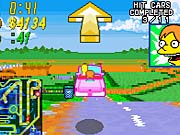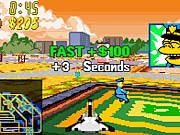You don't have to be a fan of The Simpsons TV show to appreciate how The Simpsons: Road Rage combines two of pop culture's most beloved facets: Simpsons characters and reckless driving. Unfortunately, the many flaws evident throughout the game significantly detract from what could have been an uproariously entertaining product.

The most accurate way to describe The Simpsons: Road Rage is that it's basically an imitation of Sega's Crazy Taxi set in the town of Springfield. Montgomery Burns has replaced the city's bus system with a series of expensive, nuclear-powered vehicles, and the only way for the people to get their old transit system back is to come up with a million dollars by running their own taxi business. Just as in Crazy Taxi, the goal in Road Rage is to ferry passengers to their destinations as quickly as possible. In addition to the cash you rake in from each fare, you can earn bonus bucks for taking shortcuts and driving in a manner that reflects each passenger's personality. For example, if you have Bart in the back of the cab, you'll get a bigger tip if you smack into other cars on the way to the destination.
The list of features is solid, though not spectacular. There are four single-player modes. Two of these--road rage and performance--allow you to earn money by ferrying passengers around town. In the road rage mode, you earn money for each passenger you successfully deliver. The faster you reach the destination, the more money you make and the more time is tacked on to the time limit. Once the timer expires, the money you made during that run is added to the grand total. The performance mode is somewhat different, in that you carry just one passenger during the entire run and earn money by driving recklessly in a fashion that reflects the passenger's tastes. Every time you bank a certain amount of cash, you unlock a new drivable character or one of five new locations. Each character's vehicle has its own unique handling characteristics, so there is some incentive to unlock the entire cast just to see who has the best car overall. The other single-player modes are primarily for practice, allowing you to explore the six different neighborhoods at your own pace or participate in a series of missions to improve your ability to execute expert driving maneuvers. Wrapping up the list of features is the game's only multiplayer mode, in which two players compete against one another to see who can pick up the most fares.
Although Road Rage borrows many of its core gameplay elements from Crazy Taxi, it isn't nearly as fleshed out as Sega's game. Each neighborhood has its own layout of streets, alleyways, and dirt roads, and there really isn't a set path dictating how to get to one place from another. An onscreen map and an arrow tell you where to go to drop off the passenger, but you're free to find your own way if you choose. The problem with the neighborhoods in Road Rage is that they're just too tiny. On top of that, the number of possible passengers and destinations is extremely limited. The reason Sega did so well with Crazy Taxi is that there were so many potential destinations that you were constantly exploring new areas of the city. In Road Rage, fares appear in the same spot and request the same destinations time after time. You end up feeling like you're driving back and forth between two points instead of exploring the entire city.
Graphically, the game is a mess. Altron, the developer, went with a Mode-7-style engine that takes two-dimensional courses and lays them flat to give the impression of a three-dimensional environment. You've seen this same technique at work in games like GT Advance and Mario Kart: Super Circuit. Road Rage takes the concept a step further by using the GBA's ability to distort images to work hills into the terrain. The downside of this type of engine is that buildings, signs, and other three-dimensional objects also have to be displayed using two-dimensional graphics. The GBA isn't powerful enough to display a ton of these objects at once, so there just aren't that many of them--and the structures that are visible are blocky and distorted. Instead of fences and buildings keeping you on the road, there are invisible walls that you'll run into if you drive too far outside the environment. For whatever reason, Altron also didn't bother to limit the sight distance, which means that you can see every bit of the course that isn't obstructed by a hill or a building. While this may sound like a good thing, what actually happens is that turns sneak up on you because you're distracted by objects in the distance that look like nearby barriers or buildings.

Even though the graphics could be better, the biggest problem with the game's presentation is that it doesn't flaunt The Simpsons license enough. Destinations such as the Simpsons' home, Moe's Tavern, and the Kwik-E-Mart are represented as glowing, square patches of land instead of the colorful structures we've come to recognize from television. If Bart, Lisa, Apu, Chief Wiggum, and the rest of the cast weren't in the game, you wouldn't even think the locations were in Springfield. The same goes for the audio. While the various sound effects used for the car engines and honking horns are good, there aren't any voice samples to link the game with the cartoon. A few recognizable clips from Bart or Homer would have beefed up the game's personality considerably.
Another aspect of The Simpsons: Road Rage that warrants criticism is its nasty, picture-based password save system. If you're familiar with all the characters, it's not that bad--just jot down the names or initials of the eight characters shown onscreen and you're done. Unfortunately, if you're not the kind of die-hard The Simpsons fanatic who can identify Professor Frink and Otto from their mug shots, you'll be writing lengthy notes to yourself to describe the portraits used for the password.
The concept behind The Simpsons: Road Rage is clever, but the game just doesn't deliver on its potential. You might be able to spend a weekend or two wandering the neighborhoods of Springfield just for kicks, but there are a number of other games out there that are more deserving of your attention.